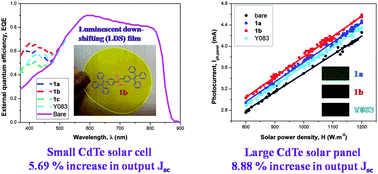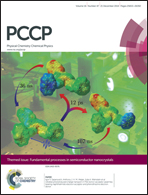Rational design of tetraphenylethylene-based luminescent down-shifting molecules: photophysical studies and photovoltaic applications in a CdTe solar cell from small to large units†
Abstract
A rational design strategy of novel fluorophores for luminescent down-shifting (LDS) application was proposed and tested in this paper. Three new fluorophores (1a–c) with specific intramolecular charge transfer (ICT) and aggregation-induced emission (AIE) characteristics were synthesized as LDS molecules for increasing the output short circuit current density (Jsc) of a CdTe solar cell. Photophysical studies of their solution and solid states, and photovoltaic measurements of their PMMA solid films applied on a CdTe solar cell suggested that the specific spectroscopic properties and Jsc enhancement effects of these molecules were highly related to their chemical structures. The Jsc enhancement effects of these fluorophores were measured on both a CdTe small cell and a large panel. An increase in the output Jsc by as high as 5.69% for a small cell and 8.88% for a large panel was observed. Compared to a traditional LDS molecule, Y083, these fluorophores exhibited more superior capabilities of LDS.


 Please wait while we load your content...
Please wait while we load your content...